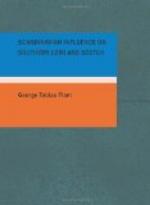5. BY IN PLACE-NAMES. CONCLUSIONS AS TO THIS TEST.
By has been regarded as a sign of Danish settlement for the following reasons: (1) O.N. boer would have given bo. The O. Dan. form byr becomes by. (2) By is peculiar to Denmark, rare in Norway. (3) Boe or bo is the form found in Insular Scotland, in the Faroes and other Norse settlements. First, the form b[`y]r is not exclusively O. Dan. It occurs several times in Old Norse sagas in the form byr and by—in “Flateyarbok,” III., 290, in “Fagrskinna” 41, several times in the “Heimskringla,” as well as elsewhere. Again, J. Vibe (see Nordisk Tidskrift, 1884, 535, and Norsk Historisk Tidskrift, 2 Raekke, 5 Bind), has shown that by is not peculiar to Denmark and rare in Norway. It occurs 600-700 times in Denmark and Skane, and 450 times in Norway. Finally, by is often found in Norse settlements in Scotland and elsewhere—in Iceland, Shetland, Orkney, Man, and in the Western Isles. In fact, by seems to be the more common form outside of Iceland. All we can say then is that by is more Danish than Norse, but may also be Norse. Where names in by are numerous it indicates that the settlements are rather Danish, but they may also be Norse. We have, then, the following results: Predominantly Danish settlements: Essex, Bedford, Buckingham, Suffolk, Norfolk, Northampton, Leicester, Rutland, Lincoln, Nottingham, Derby, East Riding. Mixed Norse and Danish settlements: North Riding, West Riding, Durham, part of Cheshire, and Southern Lancashire. Norse settlements: Cumberland, Westmoreland, North Lancashire, part of Cheshire, and parts of Northumberland. The number of Scandinavian place-names in Northumberland is not large, only 22 in Worsaae’s list. North of the Cheviot Hills the names are again predominantly Norse.
6. CHARACTERISTICS OF OLD NORTHERN,
OR OLD SCANDINAVIAN.
EARLY DIALECTAL
DIFFERENTIATION.
On the characteristics of primitive Northern and the changes that had taken place in the language before the Viking period, see Noreen, P.G.(2)I, 521-526. On pp. 523-526 are summarized the characteristics of General Northern. Until 800 the Northern tongue was unitary throughout the Scandinavian North. In the Viking age dialectal differentiations began to appear, especially in O. Dan. These are as follows (from Noreen):
About 800, older hr > r
in Denmark.
Soon after 800, older diphthongs became
simplified in Denmark,
e.g.,
au > u cp.
O. Ic. þau, O.Gutnic þaun = O. Dan. þusi
pronounced þosi.
ai, ei > i
cp. O. Ic. stein, O.N. staein, O.Gtnc.
stain =
O. Dan. stin.
io, iau > u
cp. O.N., O. Ic. briote, O.Gtnc.
briauti
= O. Dan. biruti.




